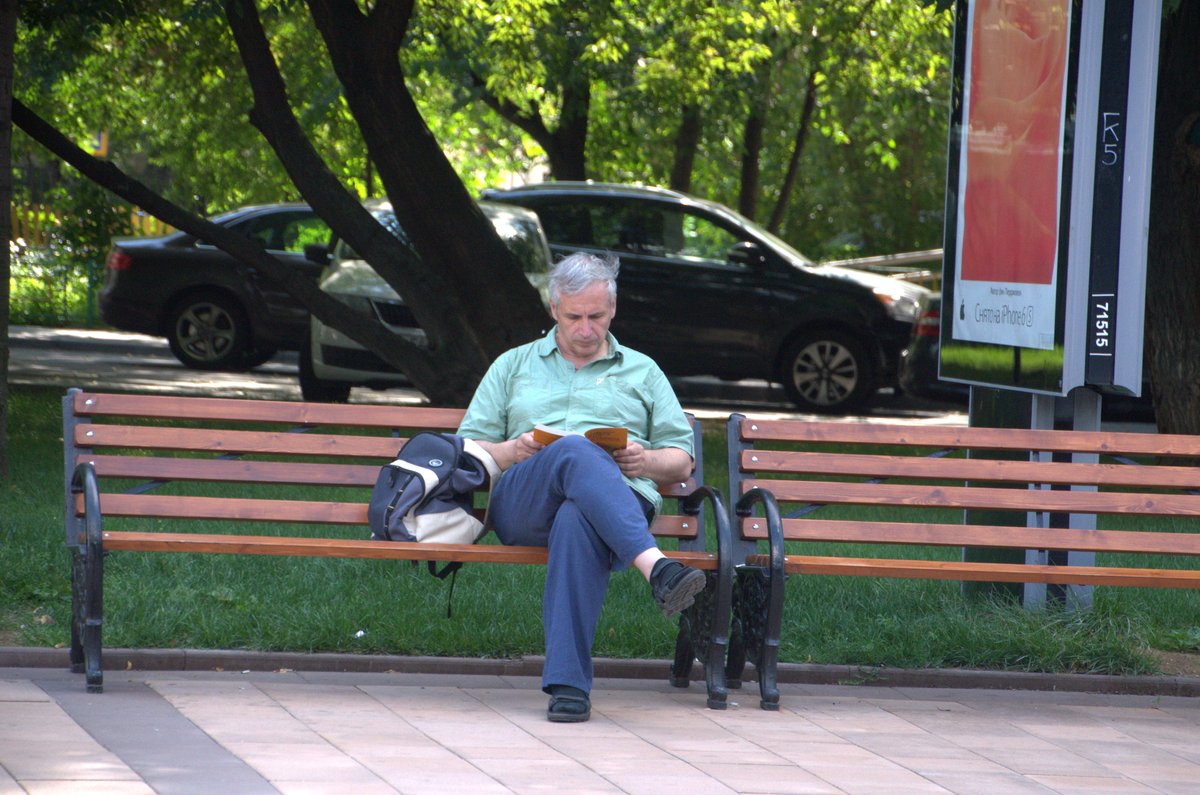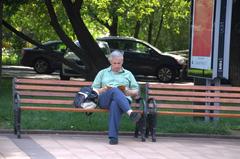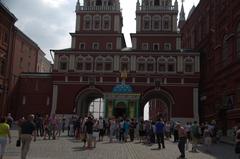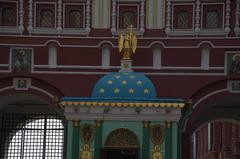
Iberian Gate and Chapel Moscow: Visiting Hours, Tickets, and Historical Significance
Date: 14/06/2025
Introduction
Standing at the northwest entrance to Moscow’s Red Square, the Iberian Gate and Chapel—also known as the Resurrection Gate and Iverskaya Chapel—are enduring symbols of Russia’s intertwined religious, architectural, and imperial history. Originally built in the late 17th century as part of the city’s Kitai-Gorod fortifications, they have served as both ceremonial gateway and sacred site, marked by the veneration of the Iveron Icon of the Mother of God. Over centuries, these structures have witnessed imperial processions, religious rituals, and the everyday passage of locals and visitors alike.
Demolished during the Soviet era to accommodate state parades and modernization, the Iberian Gate and Chapel were faithfully reconstructed in the mid-1990s, restoring their Baroque grandeur and spiritual significance. Today, they remain a focal point for travelers, spiritual pilgrims, and history enthusiasts, offering a gateway not only into Red Square but also into the heart of Moscow’s cultural identity.
This comprehensive guide covers the history, architecture, and spiritual meaning of the Iberian Gate and Chapel, alongside practical information on visiting hours, ticketing, accessibility, travel tips, and nearby attractions. For official updates and further reading, see resources such as Moscow.info, Russia Beyond, and the official Moscow tourism site.
Table of Contents
- Origins and Early Construction
- The Iveron Chapel and Icon
- Role in Moscow’s Ceremonial and Religious Life
- Destruction and Soviet Period
- Reconstruction and Revival
- Architectural Features
- Visiting Information
- Visitor Experience and Etiquette
- Frequently Asked Questions (FAQ)
- Visuals and Media Recommendations
- Related Articles and Further Reading
- Conclusion
Origins and Early Construction
The Iberian Gate and Chapel, or “Иверские ворота и часовня” in Russian, were originally constructed in 1680–1681 under Tsar Feodor III as part of Moscow’s defensive Kitai-Gorod wall (Moscow.info). The gate provided a ceremonial entrance to Red Square, marking the transition from Moscow’s bustling streets to the spiritual and political heart of the nation.
Built in the Muscovite Baroque style, the gate features two impressive arches flanked by ornate towers topped with green-tiled roofs and gilded spires. Shortly after the gate’s completion, a small chapel was added to house a copy of the Iveron (Iberian) Icon of the Mother of God, a revered symbol in Orthodox Christianity.
The Iveron Chapel and Icon
The Iveron Chapel is situated between the two main arches of the gate, enshrining a copy of the Iveron Icon of the Mother of God. The original icon, from the Iviron Monastery on Mount Athos, Greece, is famed for its miraculous powers and holds a central place in Eastern Orthodox belief (OrthodoxWiki). The Moscow copy arrived in 1648 and rapidly became a pilgrimage site and a locus of daily devotion.
For centuries, Muscovites and visiting dignitaries paused at the chapel to pray before entering Red Square or the Kremlin, a tradition that reinforced the icon’s status as a spiritual guardian for the city.
Role in Moscow’s Ceremonial and Religious Life
Through the 18th and 19th centuries, the Iberian Gate served as the principal entrance for imperial processions, state ceremonies, and religious festivals (Russia Beyond). Tsars and nobility traditionally stopped at the chapel to venerate the icon before important events, symbolically seeking divine protection. The gate stood as a threshold between the secular and the sacred, the city and the Kremlin, making it a gathering point for celebrations and national commemorations.
Destruction and Soviet Period
In 1929, as part of a campaign to secularize and modernize Moscow, the Soviet authorities demolished the Iberian Gate and Chapel (Moscow.info). Seen as an impediment to military parades and public demonstrations, the structures were removed, leaving only photographs and collective memory as reminders of their significance.
Reconstruction and Revival
With the dissolution of the Soviet Union, a movement to restore Moscow’s historic sites gained momentum. Between 1994 and 1995, the Iberian Gate and Chapel were meticulously rebuilt according to historical plans and photographs (Russia Beyond). The chapel was reconsecrated in 1995, and a new copy of the Iveron Icon was installed, reviving the site’s religious purpose and cultural importance.
Architectural Features
- Twin Towers and Arches: The gate’s two arched passageways are flanked by octagonal towers, each crowned with gilded double-headed eagles, traditional symbols of imperial Russia.
- Baroque Ornamentation: The façade displays vibrant red and white brickwork, decorative stucco, balustrades, and gilded details, reflecting late 17th-century Muscovite Baroque style.
- Iberian Chapel: Embellished with gilded pilasters, garlands, and an angel-topped dome, the chapel offers a serene space for prayer and reflection.
- Kilometre Zero Plaque: Situated just in front of the chapel, this bronze marker denotes the symbolic starting point of Russia’s highway system—a popular spot for making wishes.
The 1990s reconstruction employed traditional materials and techniques, ensuring both historical accuracy and architectural continuity.
Visiting Information
Visiting Hours
- Gate: Open 24 hours as a pedestrian passageway to Red Square.
- Chapel: Generally open daily from 7:00 AM to 7:00 PM, though hours can vary on religious holidays or during special events. It’s advisable to confirm current hours via official tourism sources.
Tickets and Accessibility
- Entry: Admission to the gate and chapel is free of charge. Donations are appreciated, particularly if you light a candle in the chapel.
- Accessibility: The area is pedestrian-friendly and mostly accessible for visitors with mobility challenges, though cobblestone paving may require caution. Ramps are available at entrances.
- Getting There: The nearest metro stations are Okhotny Ryad (Line 1), Teatralnaya (Line 2), and Ploshchad Revolyutsii (Line 3), all within short walking distance.
Best Times to Visit
- High Season: June through August offers warm weather and extended daylight; early mornings or late evenings are preferable to avoid crowds.
- Low Season: Spring and autumn provide milder temperatures and fewer visitors; winter brings a festive, snowy atmosphere but requires warm clothing.
Nearby Attractions
- Red Square: Home to St. Basil’s Cathedral, Lenin’s Mausoleum, and the GUM department store.
- State Historical Museum: Adjacent to the gate, with extensive collections on Russian history.
- Kremlin: Moscow’s iconic fortress complex, featuring palaces, cathedrals, and government buildings.
- Manege Square and Alexander Garden: Lively public spaces with fountains and memorials.
Guided Tours
Numerous tour operators offer guided walks that include the Iberian Gate and Chapel. Tours provide historical context and often include nearby attractions. Special liturgies and processions take place during major Orthodox feasts.
Visitor Experience and Etiquette
- Tradition: It is customary to pause at the chapel to light a candle or reflect before entering Red Square, following a centuries-old ritual.
- Photography: Permitted outside and generally allowed inside the chapel, though flash and loud conversation should be avoided during services.
- Dress Code: Modest attire is recommended when entering the chapel.
- Safety: The area is well-policed and safe; keep an eye on personal belongings in crowded conditions.
Frequently Asked Questions (FAQ)
Q: What are the Iberian Gate and Chapel visiting hours?
A: The gate is open 24/7; the chapel is typically open from 7:00 AM to 7:00 PM, with possible variations on religious holidays.
Q: Is there an entrance fee?
A: No, admission is free.
Q: Are guided tours available?
A: Yes, many tours of Red Square and the Kremlin include the Iberian Gate and Chapel.
Q: Is the site accessible for visitors with disabilities?
A: The surrounding area is mostly accessible, though some uneven paving exists.
Q: How do I get to the Iberian Gate?
A: Use Okhotny Ryad, Teatralnaya, or Ploshchad Revolyutsii metro stations, all within a short walk.
Q: Can I take photos at the Iberian Gate and Chapel?
A: Yes; be respectful inside the chapel, especially during services.
Visuals and Media Recommendations
- Photos: Capture the vibrant red and white façade, gilded towers, and chapel dome. Night-time illumination makes for stunning images (alt tags: “Iberian Gate illuminated at night in Moscow”).
- Virtual Tours: Some official tourism sites offer virtual explorations of Red Square and the gate.
- Maps: Include a map of Red Square showing the Iberian Gate’s location relative to metro stations and nearby landmarks.
Related Articles and Further Reading
For deeper insights into Moscow’s heritage, explore:
Conclusion
The Iberian Gate and Chapel are more than architectural marvels—they are living testaments to Moscow’s enduring spiritual and cultural identity. As both a ceremonial gateway and a place of active worship, this site bridges the gap between Russia’s storied past and its vibrant present. Whether admiring the Baroque architecture, participating in centuries-old rituals, or exploring the surrounding historic district, visitors gain a unique window into the soul of Moscow.
For the latest visitor information, guided audio tours, and cultural event updates, download the Audiala app and follow our social media channels.
Reliable Sources and Further Reading
- Iberian Gate and Chapel Moscow: Visiting Hours, Tickets & Historical Guide, 2025, Moscow.info
- Iberian Gate and Chapel in Moscow: Visiting Hours, Tickets, and Cultural Significance, 2025, Catholic Magazine
- Iberian Gate and Chapel Moscow: Visiting Hours, Tickets, and Historical Overview, 2025, Russia Beyond
- Visiting the Iberian Gate and Chapel in Moscow: Hours, Tickets, and Nearby Attractions, 2025, Moscovery
- The Iveron Icon of the Theotokos, 2025, OrthodoxWiki
- Official Russian Orthodox Church Website, 2025























































































































































































































































































